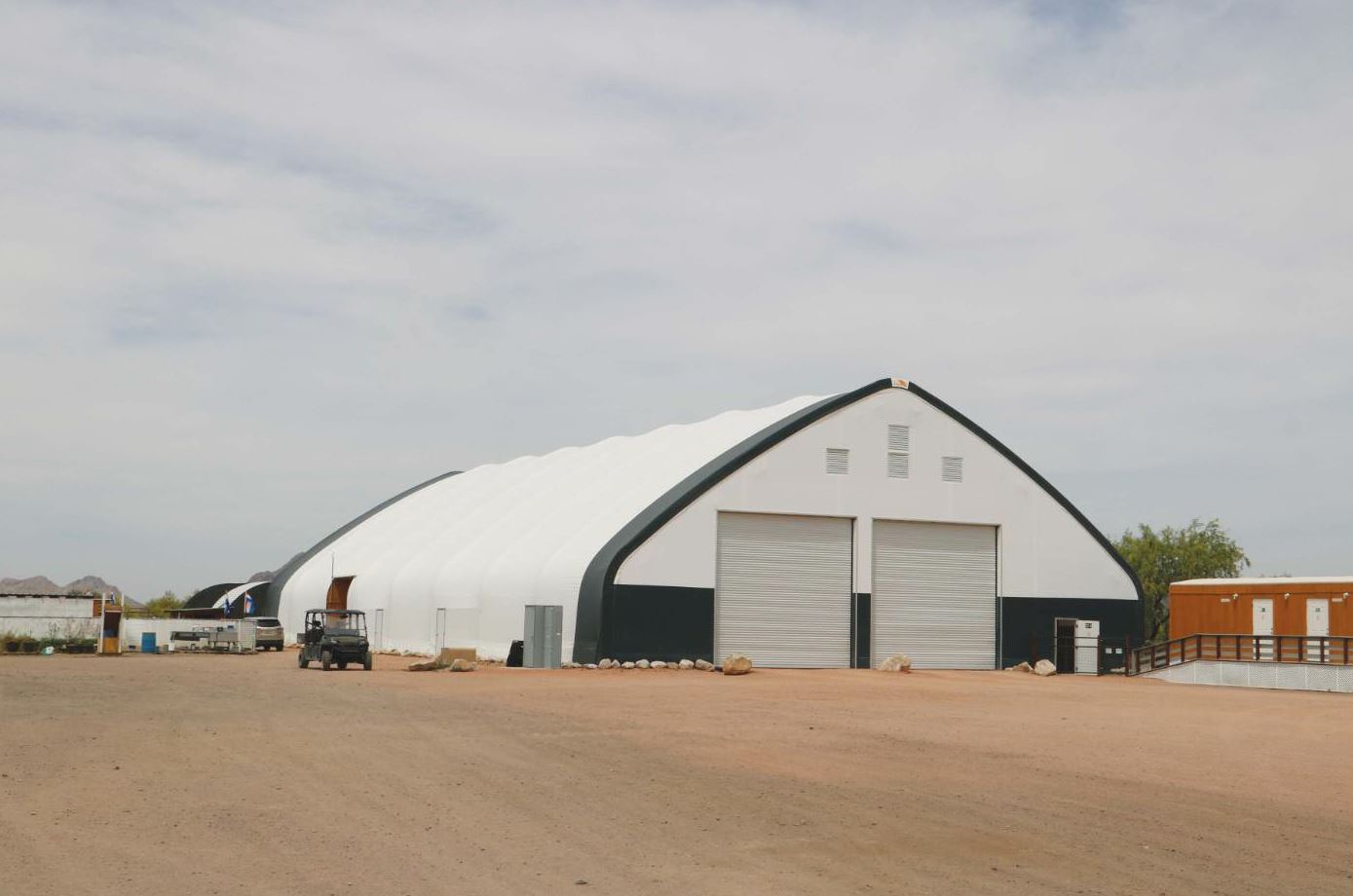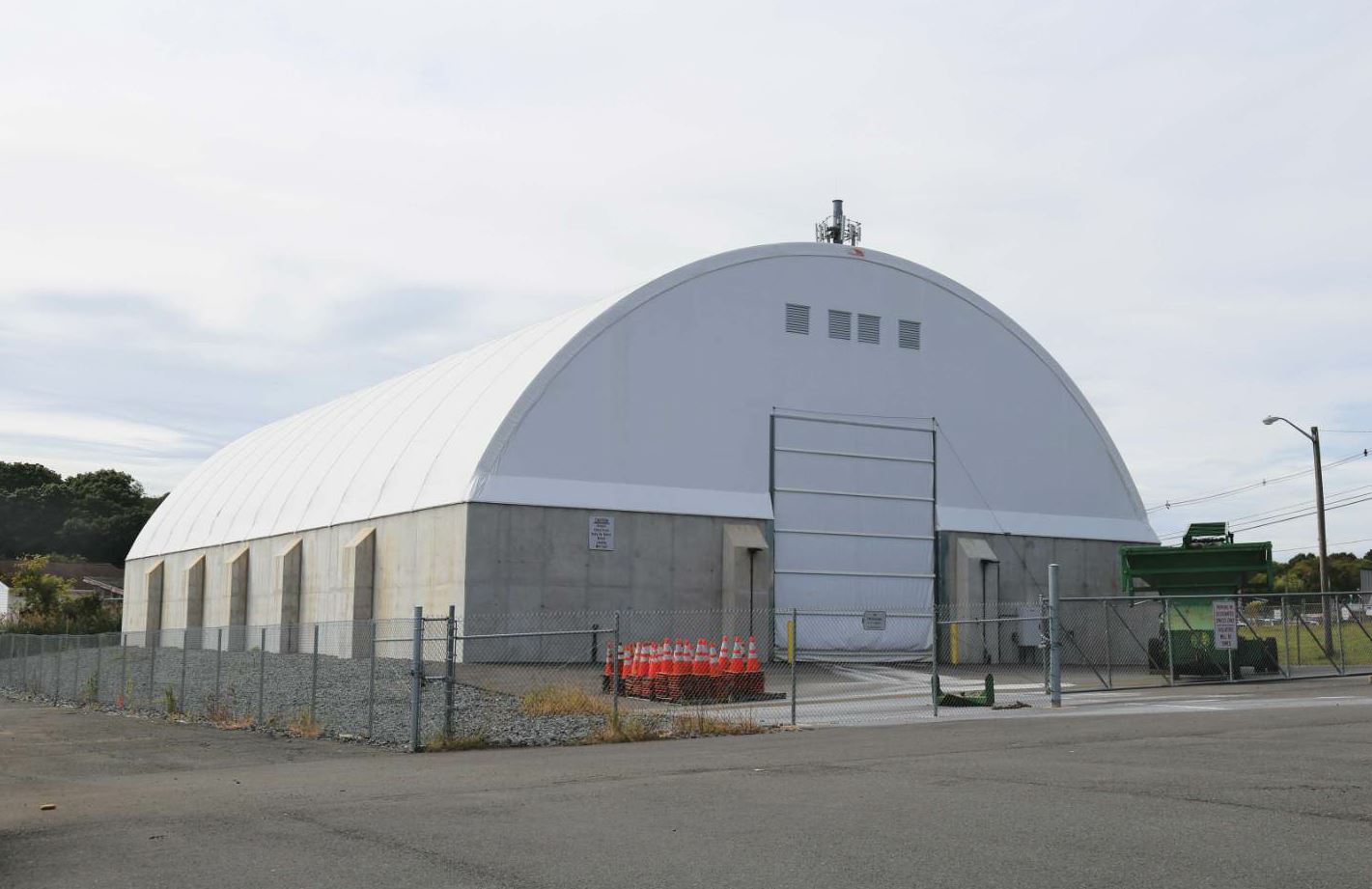How to Create a Structure that Keeps Materials Dry
BY Jessica Batchelor

Adequate space and ease of accessibility are essential in every aggregate storage building, but neither makes a difference if water damage occurs. By their very design, tension fabric structures are engineered to maximize natural ventilation, minimize condensation and withstand even the harshest weather conditions.
Let it Flow
Consistently dry buildings all have one thing in common—adequate airflow. Fabric buildings have a built-in advantage in this regard, since they do not require any internal support posts. This creates an open, clear span with plenty of clearance, thereby maximizing ventilation in a natural, cost-effective manner. For an extra boost of air circulation, some fabric structure companies can outfit a building with ridge vents, fans, end walls or side panels. This allows business owners to create air flow precisely when and where they want it.
Building and window placement can also aid the process of ventilation. Putting buildings in the direction of prevailing winds can greatly help to minimize moisture or condensation. Similarly, installing windows on opposite sides of the building will create substantially more airflow than putting windows on just one side.
Cover it Up

Fabric buildings, no matter their size or shape, keep air clean, fresh and, most importantly, dry. The building manufacturers offer a variety of roof designs, sizes and styles to accommodate any size or quantity of aggregate storage.
The tent-like rooftop of a fabric structure is far more rugged than it may appear at first glance. High-quality fabric covers are made of heavy-duty polyethylene that features a ripstop scrim to prevent tearing. Couple this with a corrosion-resistant steel frame for protection against extreme weather conditions, including heavy rain, snow, sleet and wind. Geoff Ching of ClearSpan Fabric Structures has worked on numerous fabric building projects within the storage industry and noted that, “Fabric covers are 100 percent moisture-resistant, so valuables are going to be protected no matter what.”
Fabric covers can also meet balanced and unbalanced snow load regulations, ensuring that ceiling leaks are not a source of concern. The natural ability of fabric buildings to withstand corrosive environments makes them especially valuable in marine and salt storage applications as well.
In addition to strength, fabric covers have another secret weapon when it comes to water-damage control—sunlight. White fabric covers allow plenty of natural light to pass through, which cuts down on moisture, mold and humidity year-round. Certain fabric covers even have climate-sensitive properties, keeping the interior cooler in the summer and warmer in the winter. With the combination of regular sunlight and natural ventilation, fabric buildings can consistently maintain air quality and air flow.
Foundations
Conventional buildings are often constructed on concrete foundations. Although concrete is perfectly sturdy, it is also porous and can hold onto moisture that comes up from the ground. Fabric buildings have a lot of versatility when it comes to foundation options, most notably, Ching mentioned, the helical anchoring system. Helical anchors are shaped like spirals and drill directly into the ground, creating a secure hold that is classified as temporary but durable enough to remain permanent. Without any concrete, there is a reduced risk of humidity and moisture getting to the building from the ground up.
Other popular options on which to construct fabric buildings include shipping containers, pony walls or piers. Like helical anchors, these foundations won’t absorb moisture and to boot, they add extra height to a structure, which promotes natural ventilation.
It’s important to realize that in addition to a variety of foundation options, fabric buildings are available in a wide array of styles and sizes, none of which compromise on the ability to keep storage materials dry. Many traditional buildings have flat rooftops that can collect leaves and moss, trapping moisture along with them. Fabric buildings have rounded or peaked roof designs that encourage moisture and moisture-trapping debris to slide off.
On the Side

Windows can be placed across from other windows to enhance airflow in the fabric structure.
An open-sided design is a popular style for municipalities, construction needs, bulk storage and even vehicle garages. The open side provides ample airflow and direct access to aggregate storage, so workers and vehicles can easily enter and exit the structure without having to move or rearrange storage materials. Having open sides practically guarantees an environment free of condensation. If materials need to be split up for any reason, an open-sided structure can easily be divided into separate commodity bays. If extra protection from inclement weather is desired, it’s possible to outfit an open-sided fabric structure with side panels to partially or completely enclose the side.
Although an open side can be ideal for many storage needs, it’s far from the only option for effective moisture protection. Fabric building manufacturers offer a variety of roof designs, sizes and styles to accommodate any size or quantity of aggregate storage. Many fabric structures can be constructed up to 300 feet wide and any desired length, so business owners can fit as much storage material as needed inside, while protecting it from the elements and water damage.
Superior ventilation, ample sunlight and frames made with high structural integrity all provide dependability for aggregate storage companies, no matter their application or geographic location.
Whether it’s a few expensive but large vehicles, or a massive amount of salt or sand, aggregate storage materials are an investment. All investments deserve dependable structures that will provide year-round moisture protection. Fabric buildings, no matter their size or shape, keep air clean, fresh and, most importantly, dry. For business owners across all industries, fabric buildings provide the most functional, effective solution to keeping aggregate storage materials safe from water damage.
Jessica Batchelor is a content writer for ClearSpan, which specializes in fabric structures for the asphalt industry. For more information, visit www.clearspan.com or call (866) 643-1010.
Sources in this Article
http://www.cardinalselfstorage.com/blog/6-tips-to-avoid-moisture-and-humidity-issues-in-storage
http://www.atlas-leasing.com/keep-items-dry-inside-a-shipping-container-diy-guide
